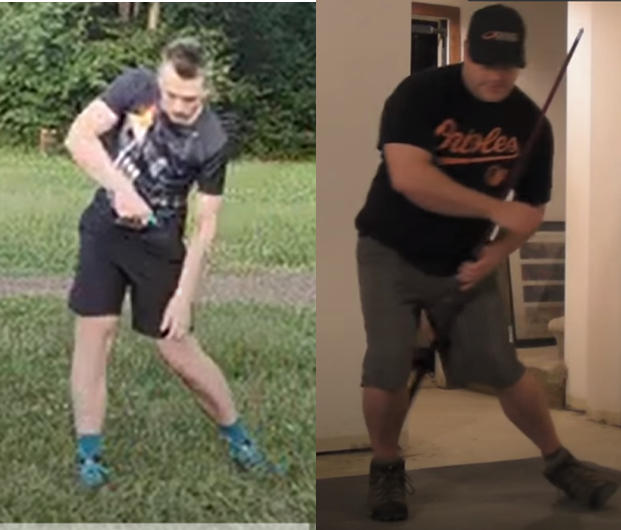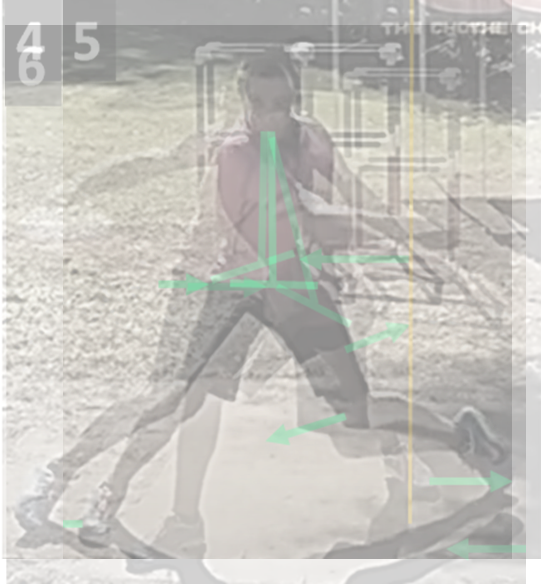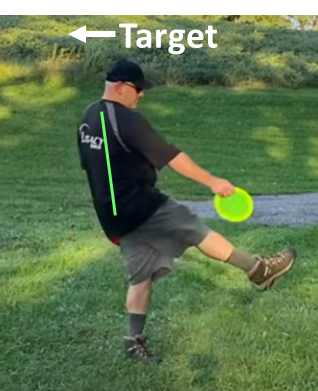^ I just want to add a couple things because as a long time Olympic lifter guy, I keep learning/revising what I do for training to keep reshaping my body for throwing.
"
athletes should focus on what they suck at relative to everything else."
-Paul Schwendel
Your first choice needs to be how serious you are about maximizing disc golf vs. other things in life. That's for you to decide.
Whatever you choose, I want to talk about strength training and throwing development. I know as well as anyone that people hold onto old habits and concepts because they love them and that they were often important for one thing or another. But if you want to throw better (and safer, and longer...) you need to be prepared to change your mental set and training style.
What's the problem with Olympic style lifts for disc golf?
You can take some posture and body loading cues from some lifting examples, but you always need to remember that throwing is about
moving from leg to leg like SW is saying there.
There's a second
extremely pernicious thing here for all my fellow lifters out there, which is that of course the neuromuscular sequence and load is somewhat different going leg to leg than it is in two-legged lifts.
This is worth saying again:
the neuromuscular sequence and load is somewhat different going leg to leg than it is in two-legged lifts.
You, my friend, probably have issues both with strength and flexibility in the "right" places (sorry to say!), and you definitely lack the neuromuscular training you need to throw with maximum efficiency.
In my own training, the old lifting program has been almost entirely replaced with loaded or unloaded motions that move from leg to leg, and do not rely on barbells or machines that force two-limbed motions. That's why even when I liked talking about the water jug holds or lifts with people, it became immediately apparent to me that you need to be moving foot to foot as soon as you get the posture cue. Otherwise people can and often do just get stuck & force the moves and sometimes get hurt. Holding something anchored against the ground with two feet is
incredibly different neuromuscularly than moving foot to foot effortlessly and learning to jettison the thing away from you.
In fact, any time a throw feels remotely like an Olympic lift, I now immediately know I need to relax, loosen up, change my breathing, move around more like throwing a medicine ball or big hammer, reset, and then get back at it.
Strength can matter, but what should you focus on besides throwing?
I hope Sidewinder agrees that you do need adequate strength in the right areas to move your mass around easily and handle the swing forces, just like you need adequate flexibility. People who grow up playing disc golf are more likely to develop those things naturally over the years adequate for their own body, and thin beanpole types popping up everywhere at the top of the distance game probably need less overall muscle mass and strength to move their less massive bodies well.
There's a problem here for people developing later in life who already have an adult body and training history. Like in pitching or baseball, it seems pretty clear in any source that I've read that Olympic-style strength doesn't add much after you reach the "adequate" plateau (which is worth talking about!) then, other things matter more. A ton of the ability to move well for throwing involves well-conditioned and well-moving stabilizing and support muscles, not just the major muscle groups that Olympic-style lifts emphasize. Barbells tend to remove those smaller muscles from the chain entirely, and you end up "trapped" in your big lift postures. So if you spent your life growing up learning to do Olympic lifts at some point rather than disc golf or related throwing potions, my money is on you having the "wrong" kinds of strength distributions across your body from the "optimum" for throwing.
There's a "vicious circle" here - if you throw
well more often, it trains your body naturally just like growing up throwing. But if your body physically can't or resists the move due to weakness or inflexibility or neuromuscular blind spots, you're going to struggle. That's where changing training habits can come in and help you.
I'm a learned optimist, and there's a little hope for people like you and me. In cases where I have discovered serious baseline weaknesses (for me, I have tested and found weaknesses in parts of my legs, core, and dynamic stabilizers), I spend only a little time with the "compound" lifts that isolate the very big muscles (maybe 3 sets), then spend the rest of my time on functional movements and lifts that challenge me to bear load safely while moving leg to leg, or on only one leg. I will probably go to my grave saying that optimizing Ride the Bull is one of the highest value whole body strength/flexibility/neuromuscular training moves available to a disc golfer. At this point I only do resistance band training for my upper body plus a few pullups and pushups - I have plenty (perhaps too much) muscle mass up there already and I became willing to lose some while shoring up my weak areas. This has been more effective for me in the last 3-6 months in terms of moving better, throwing more efficiently for longer, and mitigating injury, especially as the forces involved in my swing increased. I'll never move like I'm 20 again, but I'm starting to move more like I'm closer to 30 than 40.
Disc golf can and should learn more from baseball (IMHO)
Sidewinder understands a lot of this stuff implicitly.
Here are a couple public articles from Tread. Sure, there's salespersonship because they're running a business. But they do homework and I've gained a lot changing my routines by learning from them. Read them and consider shaking it up. You should learn about the "static/slow twitch" and "dynamic/elastic/reactive" components of strength, test yourself, and consider changing your training based on what you find. For example, I was surprised to find that after a year of using more plyometric moves, I had developed pretty good "springy" strength in some of the "posterior" parts of my legs, perhaps even better than my 20s, but somehow I left my force-bearing musculature behind. I started focusing on intermixing exercises from the "reactive/elastic" and more traditional lifting domains (from one leg to the other!) to help me legs catch up from years of inactivity that were only partially addressed by physical therapy more than a year ago.
https://treadathletics.com/high-velocity-training/
https://treadathletics.com/strength-training-baseball-isolation-exercises/
Plan like an athlete and optimize quality and recovery
Last reminder - I have reduced my drive practice (i.e., when I am pushing my movement and limits into new territory) to 1-2 days per week - because that's all my body can handle for now. Everything else I do during the week is about shoring up my body and learning in one way or another. Non-throwing days are about strength, flexibility, and neuromuscular training and resting to let my brain integrate the learning and repair my body.
<3





